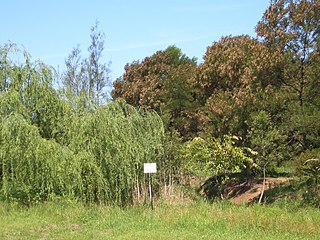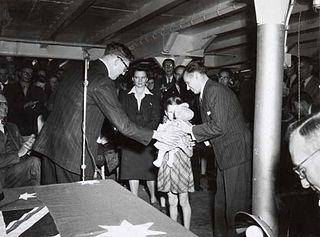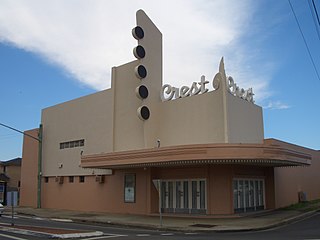
The Scheyville National Park is a protected national park that is located in the northwestern suburbs of Sydney in New South Wales, in eastern Australia. The 920-hectare (2,300-acre) national park is situated approximately 40 kilometres (25 mi) northwest of the Sydney central business district, northeast of Windsor, near the settlement of Scheyville. Longneck Lagoon lies in the northern section of the park. It was added to the New South Wales State Heritage Register on 9 April 2010.

A Nissen hut is a prefabricated steel structure originally for military use, especially as barracks, made from a 210° portion of a cylindrical skin of corrugated iron. It was designed during the First World War by the Canadian-American-British engineer and inventor Major Peter Norman Nissen. It was used also extensively during the Second World War and was adapted as the similar Quonset hut in the United States.

Fairy Meadow is a suburb in the City of Wollongong, New South Wales, Australia. Located in the Illawarra region and only 4 km from the city centre, it is a mainly low-density residential area, with a large strip of commercial and industrial properties along and off the Princes Highway.

Balgownie is a small suburb of Wollongong, New South Wales, Australia.

Potts Hill, a suburb of local government area City of Canterbury-Bankstown, is 21 kilometres south-west of the Sydney central business district, in the state of New South Wales, Australia. It is a part of the South-western Sydney region.

A hut is a small dwelling, which may be constructed of various local materials. Huts are a type of vernacular architecture because they are built of readily available materials such as wood, snow, ice, stone, grass, palm leaves, branches, clay, hides, fabric, or mud using techniques passed down through the generations.
Pennington is a northern suburb of Adelaide, South Australia, located about 10 km from the Adelaide city centre. It is located in the City of Charles Sturt.

North Market is a food hall and public market in Columbus, Ohio. The Downtown Columbus market was established in 1876, and was the second of four founded in Columbus. The market is managed by the non-profit North Market Development Authority (NDMA), which also manages North Market Bridge Park, a market in Dublin, Ohio.

Post-war immigration to Australia deals with migration to Australia in the decades immediately following World War II, and in particular refers to the predominantly European wave of immigration which occurred between 1945 and the end of the White Australia policy in 1973. In the immediate aftermath of World War II, Ben Chifley, Prime Minister of Australia (1945–1949), established the federal Department of Immigration to administer a large-scale immigration program. Chifley commissioned a report on the subject which found that Australia was in urgent need of a larger population for the purposes of defence and development and it recommended a 1% annual increase in population through increased immigration.
Lwandle/Nomzamo is a small township in the Helderberg basin just outside Strand in the Western Cape of South Africa. Both names are sometimes used interchangeably referring to both places. This may be attributed to the fact that Nomzamo was born as a result of overpopulation in Lwandle area which initially designed as a cheap accommodation for "single male workers" during the apartheid years.

Drummond Battery, also known as Fort Drummond, is a heritage-listed former coastal artillery fortification and now television station and mushroom farm at 1 Television Avenue, Mt Drummond, Mount Saint Thomas, City of Wollongong, New South Wales, Australia. It was built between 1942 and 1943 by the NSW Public Works Department and NSW Department of Main Roads. The Australian Army used the site from 1942.
Migrant hostels of South Australia are hostels where thousands of migrants passed from the 1940s to the 1980s. In South Australia these included Elder Park, Gawler, Gepps Cross, Glenelg, Hendon, Mallala, Pennington/Finsbury, Peterborough, Rosewater, Salisbury, Semaphore, Smithfield, Willaston, Whyalla, Woodside and Woodville. The hostels were temporary homes to a wide range of migrants, from Displaced Persons and refugees, through to "Ten Pound Poms".
RAAF Station Schofields is a former Royal Australian Air Force (RAAF) military air base and aerodrome located at Schofields, a suburb of Sydney in New South Wales, Australia. The aerodrome was used during World War II and was in operation between 1942 and 1944.
The Iris hut is a prefabricated steel structure used by the British military predominantly during the early part of the Second World War. They served as barracks, workshops, and storage facilities in World War II Great Britain.

Commonwealth Acetate of Lime Factory is a heritage-listed factory at 82 Colmslie Road, Morningside, City of Brisbane, Queensland, Australia. It is also known as Colmslie Migrant Hostel, Fairmile Naval Base, Hans Continental Smallgoods Factory, and HMAS Moreton, Colmslie. It was added to the Queensland Heritage Register on 7 December 2007.

The Benalla Migrant Camp, formally known as the Benalla Holding Centre and the Benalla Migrant Accommodation Centre, was one of 23 similar camps established by the Australian government to provide temporary housing for non-British new arrivals in post-World War II Australia. The Camp occupied the former Royal Australian Air Force (RAAF) No.11 Elementary Flying Training School (1941-1944), adjacent to a small aerodrome on the outskirts of Benalla in north east Victoria. Opening in 1949, the Benalla Migrant Camp was a modest-sized holding centre, accommodating 200 – 400 people. It survived national reviews of migrant accommodation needs in 1953 and 1959, but by 1967, the number of residents had diminished sufficiently for the Camp to close. By that time, over 60,000 people — mainly of Polish, Latvian, Lithuanian, German and Estonian origins, as well as other nationalities — had been accommodated there.

Regent Theatre is a heritage-listed former theatre and cinema at 197 Keira Street, Wollongong, City of Wollongong, New South Wales, Australia. It was designed by Reginald J. Magoffin with an interior by Marion Hall Best and built from 1950 to 1954. It was added to the New South Wales State Heritage Register on 9 May 2005.

Crest Theatre is a heritage-listed former cinema and ballroom and now community centre at 157 Blaxcell Street, Granville, City of Parramatta, New South Wales, Australia. It was designed by Cowper and Murphy and Associates and built in 1948 by A. W. Edwards Pty Ltd. It is also known as Hoyts Crest Theatre. Following its purchase by the Australian Blouza Association, it has been referred to as Blouza Hall. It was added to the New South Wales State Heritage Register on 1 August 2003.

The Cumberland Street Archaeological Site is a heritage-listed archaeological site located at 106–128 Cumberland Street in the inner-city Sydney suburb of The Rocks in the City of Sydney local government area of New South Wales, Australia. The site includes the remains of early convict-era housing dating as far back as 1795, and a modern youth hostel has been built elevated over the remnants. It is also known as The Big Dig Site,Sydney YHA, and theBig Dig Education Centre. The property is owned by Property NSW, an agency of the Government of New South Wales, and it was added to the New South Wales State Heritage Register on 17 December 2010.

69 Windmill Street, Millers Point is a heritage-listed residence and former retail building located at 69 Windmill Street, in the inner city Sydney suburb of Millers Point in the City of Sydney local government area of New South Wales, Australia. It was built from 1845 to 1901. It is also known as Hit or Miss Hotel; Empire Service Hostel. It was added to the New South Wales State Heritage Register on 2 April 1999.

















